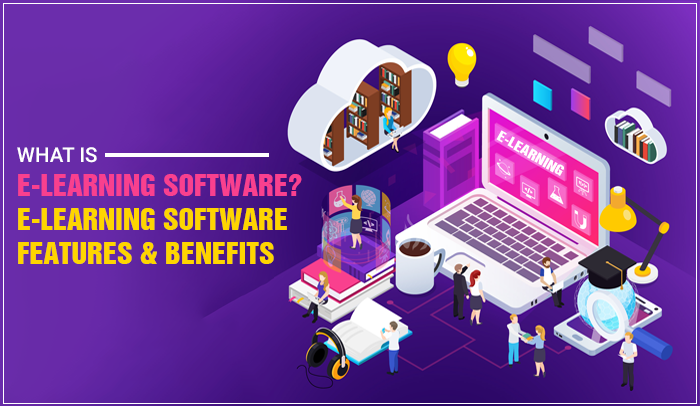E-learning is the idea that learning may be facilitated and performance can be enhanced by using computer technology and the Internet. That is, using new technology, gadgets, and appliances that we all have at home, such computers, tablets, and even smartphones, to carry out the teaching-learning process for each student.
The physical connection between a student and an instructor is eliminated by e-learning because each platform only allows for technical communication. The student is the centre of attention and the entire body of knowledge in this learning model revolves around him. Each person can decide what knowledge they want to learn, when they want to learn it, and how they want to learn it, which was not feasible before the invention of distance learning. In this article we will discuss about:
- What is an LMS or e-learning software?
- E-learning software for training institutes
- E-learning software features
- Benefits of best e- learning sofware
- How e-learning software works
- Communication tools for online education
- Best e- learning software developers
What is an LMS or e-learning software?
A platform, or location where content can be created or uploaded, is required in order to conduct distant education. This is the starting point from which all students registered in a course that uses a platform that has been contracted can access the material. They can access the materials that the tutor or teacher has uploaded there.
In other words, a user-interactive LMS is similar to a social network. Although there are spaces available on most platforms for students to contribute any ideas or work they have done, teachers are the ones who manage and mould it through projects and material. It is vital to be informed about all factors when selecting an e-learning platform because there are many distinct styles of platforms that offer various functionalities. The benefit is that each organisation interested in providing remote education can select the kind of platform that best meets their requirements.
E-learning software for training institutes
Corporate e-learning training is intended for businesses that educate their staff, clients, or distributors. Compared to conventional training, it has a number of benefits. Companies will be able to save that 60% on employee travel and lodging expenses because to distance learning. Additionally, because the courses are not restricted to small groups, it is feasible to instruct a lot more people at once. The provided courses may be consulted by the students as often as desired.
Academic training: E-learning is an excellent tool for academies or institutions to supplement in-person instruction or to provide more flexibility by introducing semi-presential teaching modes. The ability to extend their business outside of the immediate area is another benefit of distance learning for these academies.
Training for businesses: Consulting organisations looking to provide specialised training to businesses find new opportunities and a valuable resource in e-learning. Companies are requesting this kind of training more frequently, so it is important to fulfil the client's requests. Additionally, by assisting their clients in cost-cutting through this type of teaching-learning, consulting businesses can benefit their clients.
E-learning software features
Anyone, anywhere, at any time
Worldwide access to education will be made possible by the expansion of the World Wide Web, high-capacity business networks, and high-speed desktop computers. Businesses will be able to easily and conveniently transmit important information and training to numerous places thanks to this. Then, at their convenience, employees can receive training at home or at work.
Offers chances for reflection
Through thought-provoking self-reflective learning tests, learner-centered eLearning offers opportunity for learners to apply knowledge to their role or personal situation.
Successful education
E-learning has a good impact since it makes it simple to understand the material, which leads to better performance on tests, evaluations, and certifications. It improves one's capacity to pick up new information and use it in the workplace. by assisting with longer-term memory retention.
User-friendly, simple
Learners may take charge and easily find what they need using learner-centered eLearning, which is simple to use. The course should be designed with strong user experience standards in mind so that learners may move around it naturally.
Personalized education
Instead than speaking to the learning audience as a whole, the information in learner-centered eLearning talks to the individual student. This fosters an emotional connection with the material and gives the impression of a customised learning experience.
Less Environmental Impact
Because eLearning doesn't use paper, it greatly benefits the environment because no trees are cut down to make paper. According to a study on online courses, distance learning programmes use about 90% less energy and produce 85% less carbon dioxide emissions than conventional campus-based educational programmes. Through eLearning Thus, eLearning is a very environmentally friendly method of education.
Benefits of best e- learning sofware
Online training is in greater demand than ever in these times of transition where we must be ready for teleworking and work-life balance. Here are ten benefits that will help you get started with e-learning right away.
The learner actively engages in the process of learning: The student must put up a lot of effort to learn using the e-Learning system. This approach, the student develops critical abilities like reasoning, accountability, and decision-making in addition to theoretical knowledge.
Training is customised to each student's rate of learning: for this reason, most e-Learning courses are lengthy. As a result, this kind of training gives every student the option of doing it at their own pace and taking the time they need to learn everything.
Follow-up from the teaching staff: Contrary to popular belief, receiving instruction online does not mean that a student is by themselves. You can get in touch with your virtual instructor using the online platform to get any questions answered, and the tutor can also stay updated on the student's progress at all times.
Time flexibility is unquestionably one of the biggest benefits of e-Learning instruction. The student has a lot of schedule flexibility since they are not required to physically attend sessions. This gives the student complete freedom to balance his training with his personal and professional life.
Crossing geographic obstacles: There are no geographical barriers with online training, which is one of its many excellent advantages and one that more and more individuals worldwide are choosing. A student's options for education are not restricted to the region in which they currently reside; instead, they have access to courses and programmes from universities on all five continents with just a few clicks.
Cost-cutting measures like flexible scheduling and time-saving travel results in lower expenditures for the student. A course offered through e-Learning may cost 30% less than one in a traditional classroom setting.
Numerous online resources: e-Learning courses offer a wide range of tools, resources, and materials that aid the student during the entirety of his instruction, including videos, supplemental materials, and direct interaction with the tutor...
Updated information: The world we live in today is constantly changing. As a result, a book on a particular topic may become outdated within a few months. In contrast, the teaching staff of an online course hangs only the materials they deem most appropriate. Additionally, they could possibly be modified at any time. The student is assured of receiving knowledge that is wholly current in this way.
Unlike classroom training, which is governed by extremely specific dates and timetables, e-Learning training begins when the user selects it. However, with e-Learning training, students benefit from having unlimited access to their course whenever it is most convenient for them, with no restrictions. They merely need an Internet connection in order to access the course materials.
Partner interaction: Because it is an online course, couples can still interact. The majority of e-learning platforms give all of their users the option to connect through a forum where they may communicate, ask questions, and more.
How e-learning software works
Learning portals, hyperlinked pages, screen cam tutorials, streaming audio and video, and live Web broadcasts are examples of static ways for delivering instruction. Interactive methods include threaded conversations, chats, and desktop video conferencing.
Early on, e-learning platforms mainly made it possible for teachers to distribute lesson plans directly to students. Through the use of increasingly interactive tools, the e-learning experience has now evolved to permit more multidirectional dialogue. There is more flexibility in how students, employees, and independent learners choose to consume and react to e-learning content, and any number of peers can be involved.
In order to ensure an effective e-learning programme, an organisation should adhere to the following three criteria, regardless of the particular platform they choose:
Mobile users should like the experience. Mobile phone usage is expanding in the workplace. Phones can be used to deliver training reminders, instructions, or congrats for successful training.
Social elements should be included in the experience. Learners are given a platform to reply to training efforts or general company updates as well as engage with their peers and employers by using social media, or a platform that imitates social media's basic capabilities.
To accommodate various learning preferences, the experience should make use of a range of different media, such as quizzes, infographics, podcasts, demonstrations, and narrative-based instruction.
Communication tools for online education
E-learning opponents claim that the crucial communication component of instruction is lost with distance learning. There are numerous methods that allow instructors and students in distance education to communicate, even though it is true that the best communication is personal, face-to-face, and occurring at the same time.
- chat
- videoconferencing
- forums
- social networking
Are You Seeking Skilled and best eLearning Software Developers?
Contact us with your needs to schedule a free 30-minute consultation with our professionals.
For the different requirements of the learning and development (L&D) industry, we have years of expertise building bespoke Education & eLearning solutions. With the aid of cutting-edge technologies like AI, IoT, AR, VR, etc. and a client-centric development methodology, we provide industry-specific solutions that stress tailored learning while also making learning more entertaining.
Let's talk about your project demands when we get in touch.
We value your understanding of your goals and requirements. To develop a really distinctive and unforgettable experience, we collaborate and listen.
Message to [email protected]
Phone: +91 786 938 6777




